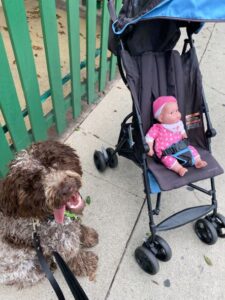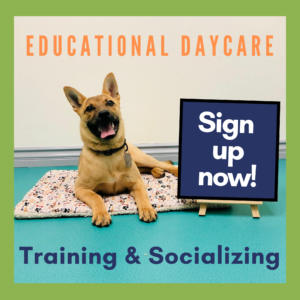Do you have a dog? Are you expecting a baby? Let’s talk. As a mom and a dog trainer, I want to set you and your dog up for success. So let’s discuss some ways we can prepare for your new arrival.
In an ideal world, these things can be accomplished, however, everyone’s situation is different. The below mentioned may not all be realistic for you and that’s okay, try to achieve what you can before the baby arrives.
Safe Zone
Get your dog used to an enclosed safe zone. This can be a crate, a pen, a kennel, or a blocked-off area of your home. We want your dog to feel comfortable in this space, be able to be in this space for several hours without having potty accidents, and without causing destruction or barking. The last thing you need when the baby arrives is a dog constantly barking because they are not comfortable in its safe zone. A safe zone will help to keep you, your dog, and most importantly baby safe. This is an area that provides distance and space between the dog and the baby, which will be extremely important as the baby grows. Not to scare you, but to prepare you, here are some facts surrounding children and dog bites:
Over 77% of dog bites come from a family or friend’s dog.
Children are most likely to be bitten
Bites towards children most often occur when adults are not actively supervising
Bites toward children most often occur in the face or neck area
Bites do NOT happen out of the blue, there is always a series of body language leading up to a bite that often goes unnoticed.
I am always thinking about these things. It is a huge weight off my shoulders to know that my dog has a safe zone where she is comfortable, so I can be comfortable. My dog is so tolerant and so good with my kids, but she is still a dog, and it is my responsibility to keep her safe and my children safe. So in her crate she will go when I am not able to be fully attentive to her when around my children. Having to have eyes on the dog and baby at all times can be exhausting. So if they are in their safe zone, it is one less thing you need to stress about.
Enrichment Prep
Purchase, make, or collect enrichment items you can bring out and have ready when needed. What does this mean? Enrichment is providing your dog with ways they can be a dog, use their senses and mentally stimulate them. Enrichment has an extremely wide range of possibilities, but one great outlet is to provide our dogs with ways they can work for their food. This can be done through the endless interactive food toys and puzzles that are available for sale at your local pet stores, online, and here at school. Through homemade or recycled items such as paper, boxes, paper rolls, egg cartons, and more. (Need more enrichment ideas follow us on social media!)
So why is enrichment important? Allowing your dog the opportunity to work for their food gets them mental and physical exercise and it keeps them busy and quiet. So throw your amazon boxes in the closet, start collecting your TP rolls, invest in a variety of items such as kongs and other interactive toys, and stock up on chews such as bully sticks, no hide rawhides, frozen bones, pig ears, and hooves. If able, prep your food toys and freeze them so they are ready to go. When you need them. Key times are: while they are in their safe zone, when the baby is sleeping when you need to do some housework, meal time, the list is endless really. It is very likely you will not be as attentive to your dog as you used to be, so they may not be getting the same amount of physical or mental exercise they did before the baby. That’s okay, it’s normal, so to help provide a balance we can spoil them in other ways, i.e. by providing plenty of enrichment.
In a previous Blog, It’s National Puppy Day! So let’s talk about puppies!, I mentioned the idea of having a puppy shower. This idea can be great for those expecting a new baby. Add a few pet enrichment items to your baby wish list so friends and family can help you stock up on needed items to make your new parent experience a bit smoother.
Hospital Prep
As you pack your hospital bag don’t forget to think about what you are going to do with your dog while you are away. They can’t go with you, so make sure to arrange for them to be boarded, stay with friends or family or hire a professional pet sitter. Your doctor may have you prepare a bag ready to go when you need to leave for the hospital. In addition to that bag, have a bag ready to go with dog food, treats, and any medication your dog may need while you are away. These are not things you want to think about when you are on your way to the hospital.
In addition to having a place for your dog to stay while having the baby, it is also nice to have a planned helper for the first month of having a newborn. This can be enrolling in educational day care, hiring a dog walker to help relieve some of your dog’s energy or having a friend or family member visit regularly to help with normal dog responsibilities (poop pick up, deep cleaning dog dishes and enrichment items). Personally, I have had friends and family assist me in these areas when my kids were born, and it was extremely helpful.
Baby Practice
Some dogs will fit right into a new routine and be perfectly fine with a new addition to the home, but that is NOT always the case. No matter if you have an extremely tolerant and easygoing dog or a more sensitive pup, it is always better to prepare your dog as much as possible before the baby arrives. Here are some ways you can help practice:
Baby sound desensitization
Whether it is the sound of a baby crying, a baby laughing or sound they may hear from toys or machines, introduce your dog to these sounds starting at a very low volume or a distance away. Pair these sounds with positive associations such as treats, affection or toys. Slowly with time increase the volume of the sound. Keep your dog’s body language in mind, work at a level where your dog is displaying calm and relaxed body language. Let a trainer know if the sounds seem to cause your dog stress, we can help you with the desensitization process. A great book to invest in to learn more about dog body language is Doggie Language by Lili Chin, a book available for sale here at school.
Pretend baby- With sound desensitization can also come visual desensitization. Your dog will not only hear new things but also see new things. Set up a few of your baby’s items before they arrive. A crib, a swing, car seat, a stroller or a high chair. Get your dog used to these objects, especially the ones that move. Additionally, once your dog is comfortable with the sound desensitization you have been doing you can pair the sound with the item. You can also practice attending to the sounds. Wrap a bag of flour in a baby blanket or invest in a baby doll to pretend with. Practice holding, changing, caring and soothing baby so your movements and responses to the sounds are familiar.
You may be wondering how you can help prepare your dog for the smell of the new baby. For those who are pregnant and their dog lives with them your dog already smells your baby in your belly. For those who are adopting or have a surrogate here are a few things you can do: Bring home the baby’s hospital blanket and allow your dog to smell and investigate it before actually meeting the baby. If you have friends or family members with babies or young children you can ask to borrow a few of their used clothing, ask your surrogate if you can borrow a shirt or blanket they have been using. Introduce these pieces of clothing to your dog, allow them to smell, explore and investigate.
Obedience Training
Basic obedience is helpful for any dog owner, but especially those who have a new baby in the home. Refine or review with your dog some cues that may be helpful for them to have when the baby comes such as: sit, down, come, place and stay. Teach your dog a few tricks that can not only be cute but also helpful such as back up, pick it up, touch or on or off a surface on cue. But what is most important for your dog to have are skills relating to impulse control: not grabbing or taking things off of counters or things that fall on the floor, not laying on baby blankets when on the floor, dropping items when asked, and not jumping up on you or baby. You may also want to consider doing some resource guarding prevention to help build trust and avoid conflicts between dog and baby as they most certainly will arise as your baby grows and starts to crawl and explore the world.
How do you teach these things, what should you focus on first? How will you ever have time to do all this prep work? Give us a call. We can help guide you through this process and help prepare you and your dog, you are not alone, it takes a village to raise a child, let us be a part of your village and help out with your dog.
Here are additional resources to help prepare you and your dog for a new baby:
- The Family Dog
- Family Paws Parent Education
- Pooch Parenting
- Living with Kids and Dogs Without Losing Your Mind Book by Colleen Pelar
- Living with Kids and Dogs
- Hey Dog! Sniffs are for Feet! Book by Wendy Keefer
- TheBlueDog.org




